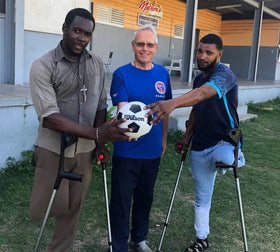Crutches Anyone? by Thomas Fetterman
Walking sticks have aided bi-pedal man since the dawn of our evolution. The walking stick has served us well as an assist to climbing, an aid to steadying ourselves, as a probe, a reaching tool, a weapon, as an artistic expression, and for some, as weight-bearing device to facilitate ambulating when debilitated.
As we became more sophisticated our walking sticks developed specialized functions for specific needs such as hook shaped top to heard sheep or a T shaped top to nestle in the pit of the underarm for a rudimentary crutch.
Form was driven by its need to function and was shaped for the individuals needs often by the individual themselves.
The mid 19th Century brought this country two things that changed the humble walking stick forever: the Industrial Revolution and the battlefields of the Civil War and ensuing World Wars. The wholesale demands for crutches spurred by a sea of casualties disallowed the luxury of hand whittled, custom designed walking devices. Crutch mills were born in the abundant hardwood forests of New England to meet the demand.
A major design change from the T shaped crutch took place as the "bow" underarm crutch was developed. These early manufactured crutches were called "Splits". They are made by sawing a single long piece of hardwood down ¾'s of its length, then spreading the top apart in a "V" shape and affixing a wooden cradle shaped underarm piece to the top and lower down, a handle. The early models were very basic and did not have tips or padding of any kind.
This underarm bow crutch proved very useful to the may soldiers who sustained leg amputations because it is possible to tuck the upper arm between the bows tightly and walk without a hand on the handle, freeing up an arm to carry large loads. Though underarm crutches have been proven less energy efficient and more cumbersome than forearm crutches, they are still preferred today by many long-term users for this reason.
For those who chose to afford it, a deluxe crutch was designed. In place of the unforgiving wooden underarm piece is a "sling top"; a firm leather wrapped hammock-like pouch stuffed with the long hairs of a horse's tail for strength.
The bows of the crutch above the handle were steam bent to form subtle opposing "S" curves that function like leaf springs as they are drawn together when body-weight is applied. The soft "sling top" is still the most comfortable and least deleterious underarm crutch available today. Beautiful hand-crafted "sling top" crutches are still custom-made to order by the owner of the Kelley Crutch Mill in New Hampshire using the same jigs and steam boxes as it did in the Civil War.
The tips of these early manufactured crutches and canes were non-existent or made of metal because the terrain at the time was mostly soft and rugged. Although the invention of the vulcanization process by Charles Goodyear patented in 1844 allowed for the creation of a metal device affixed permanently to the wooden crutch end that held a rubber pad, very few were used. It wasn't until the turn of the century when hard, smooth manmade surfaces became dominant that rubber tips became common.
World War I provided the need for more advances in crutch tip technology. In 1919, George Hippwood patented a sophisticated crutch tip with an air bladder inside. His patent also shows one of the first height adjustable underarm supports that later evolved into the adjustable underarm crutch issued by hospitals today for the short-term user market.
The Polio epidemics effected all ages and the virus attacked different parts of the body. When a person had both affected legs and weakened arms it was necessary to support the biceps and the triceps. With Franklin Delano Roosevelt's help, the Warm Springs Crutch was designed with a metal cuff above and below the elbow for the extra needed support.
Others like myself who had paralyzed legs but unaffected arm strength were issued the Kenny "arm-band" crutch. The Kenny crutch, named after Sister Kenny is a wooden bow crutch similar to the sling top wooden bow crutch but instead of the sling top there is a wide circular leather band attached to the top of the crutch. This fits loosely around the forearm.
This type crutch was issued to many polio victims (myself included) and was particularly good for children because the soft leather cuffs were very forgiving during a fall and didn't entrap the arm. Unfortunately, because of their association with polio poster children Kenny crutches are no longer desirable to the parents of today's young disabled.
World War II and the Korean War along with another polio epidemic provided customers for the next major change in crutch design. The forearm style crutch, often referred to as the Loftstrand crutch, the brand name of one of the early manufactures, was a boon to its users. The forearm style crutch now dominates the world's long-term crutch user market. In fact in Europe the forearm crutch is the style of choice for the short-term user market as well.
Many companies in the United States currently manufacture forearm crutches. These massed produced crutches have many similar attributes in common. They are made out of aluminum tubing with adjustment holes above and below the handgrip so that one size fits all. The arm cuffs are made of metal and the handgrips and crutch tips are made of solid elastomers.
Unfortunately many of these attributes leave a lot to be desired but are endemic to the manufacturing process itself which in it's attempt to make an inexpensive crutch to accommodate the needs of everyone, ends up not meeting the needs of anyone effectively.
As an active teenager I destroyed these aluminum forearm crutches at the rate of 3-4 pairs a year. The adjustment holes soon would "egg-out" from the tremendous amount of applied torque. Before they failed completely they clicked and clacked with every step and I sounded like the "Tin Man" echoing down the halls of my school. Everyone would see me coming but I was always annoyed that they could hear me coming as well.
My parents bought the available rubber crutch tips by the case because the hollow end of the crutch tube would catch the floating metal washer inside the tip and eject it through the side wall causing the tube to die-cut through the bottom. This would often send me flying to the ground.
I fell regularly. This would bend the metal cuff out with each fall. Bending the cuffs back in shape would weaken them until the metal would fatigue and break. I spent hours repairing my crutches and developed a large stock of broken crutch parts and at the same time some passable mechanical skills. Many years later, when I had shaken off the paternalistic pressure to accept these fragile, heavy, noisy, hard-riding, callous causing, institutional gray looking crutches as my lot in life, I set out to change things.
In the late 1980's, after 30 years crutch walking my shoulders developed more and more pains when I was active. My doctor told me to slow down and take aspirin. Instead, I decided to design a shock absorbing system for crutches.
An engineer told me that approximately three times my body weight gets cast upon my shoulders with each step. And because like many active people I walk between 6-8,000 steps a day there are literally tons of negative ground impact forces applied to my hands, arms and shoulders. No wonder we ache!
After considerable experimenting I developed and patented a crutch tip design that has a built-in shock-absorbing gel polymer pad called AbsorbaliteTM. An oversized steel disk is chemically bonded above the gel pad. The crutch shaft becomes a piston rod as it pushes against the disk and gel pad. The pad and side walls of the tip balloon out as the gel distorts and transforms the impact forces into heat instead of passing the energy up the crutch shaft to be absorbed by the body.
The high comfort level afforded by this design has resulted in relief from the "crutch pain" for myself and many others (more than 30,000 pairs sold). Because they are hand assembled and use expensive materials, PerformanceTM tips and the smaller TornadoTM tips seem pricey at first. However they wear 3 to 5 times longer than ordinary tips so they work out to be a good value.
The more I spoke with my crutch tip customers I realized we shared the same complaints about manufactured forearm crutches. I joined with Enabling Technologies in 1991 who design and build excellent quality SuperliteTM custom-made crutches. By making crutches without adjustment holes the strength and durability is substantially increased and they are forever silent because there are no moving parts. They are also much lighter than manufactured crutches and will even float on the surface of water.
Over the years we have continued to improve Superlite forearm crutches. I've developed Performance gel handgrips for added shock protection and comfort and added a padded leather cuff inserts for the unbreakable, adjustable cuffs made of Dupont ZytelTM nylon. We now offer a wide selection of "bright dipped" anodized colors. And to protect the bottom six inches of the crutch that is used to hold a door open we install black PVC "door guard" sleeves.
Our high tech, high style crutches have not gone unnoticed. Last year when President Clinton injured his knee the White House purchased a pair of Superlites. When questioned about his snazzy black Superlites, President Clinton replied "I call them my Stealth crutches…I think they were developed as an offshoot of B-2 technology. I like them quite a lot."
We now hand-make many different styles of crutches to order like the old days, often making them from tracings of existing crutches. We also create new designs to meet specific needs. As we move into the next century our goal is to preserve the best of the past using the materials and technology of the future.

